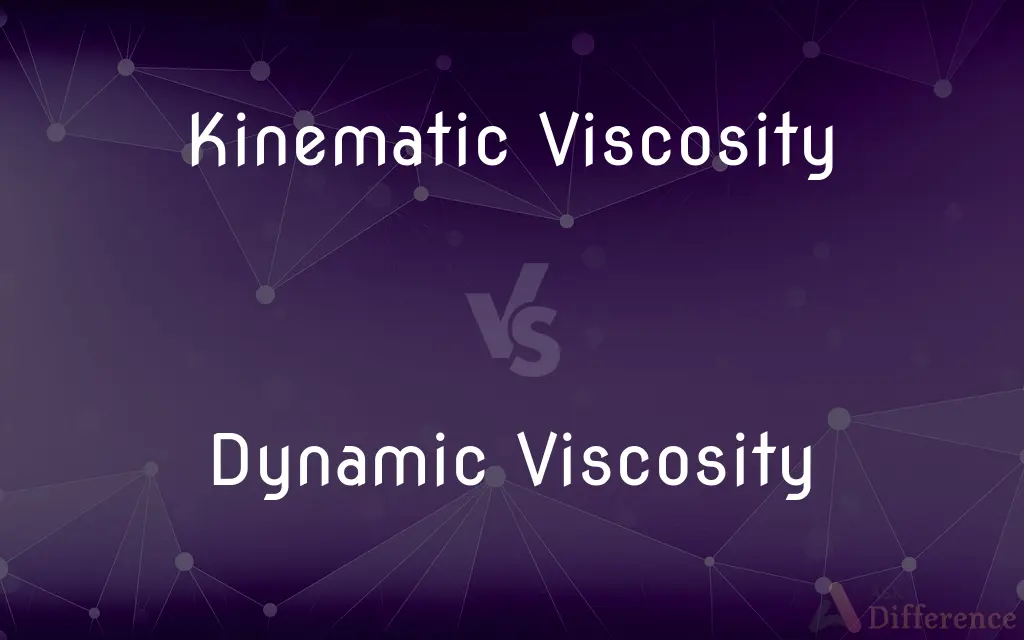Kinematic Viscosity vs. Dynamic Viscosity — What's the Difference?
By Tayyaba Rehman — Published on January 13, 2024
Kinematic viscosity measures a fluid's resistance to flow under gravity, while dynamic viscosity measures resistance to shear flow, typically under external force.

Difference Between Kinematic Viscosity and Dynamic Viscosity
Table of Contents
ADVERTISEMENT
Key Differences
Kinematic viscosity, denoted by nu (ν), is the ratio of dynamic viscosity to fluid density. It represents the fluid's resistance to flow due to its internal friction when acted upon by gravity. Dynamic viscosity, denoted by mu (μ), is the measure of a fluid's internal resistance to flow when an external force is applied, irrespective of its density.
While kinematic viscosity is expressed in units of area per time, typically square meters per second (m²/s), dynamic viscosity is expressed in pascal-seconds (Pa·s) which reflects the force per unit area required to move a fluid layer over another. Kinematic viscosity is often used when dealing with large bodies of fluid, such as in hydrodynamics, whereas dynamic viscosity is more common in engineering applications where pumps and systems exert force on fluids.
The calculation of kinematic viscosity is important for understanding how fluids will move in a system where gravity is the predominant force causing flow, such as in sedimentation processes. Dynamic viscosity is crucial for designing mechanical systems where fluids must be pumped or stirred, as it defines the energy required for such processes.
In essence, kinematic viscosity could be thought of as how quickly a fluid spreads out, while dynamic viscosity could be seen as how hard it is to get the fluid moving. They are related but are used for different types of fluid flow analysis.
Comparison Chart
Basic Definition
Fluid's resistance under gravity
Fluid's resistance to shear under force
ADVERTISEMENT
Units
Square meters per second (m²/s)
Pascal-seconds (Pa·s)
Related to
Fluid density
Shear stress
Typical Use
Hydrodynamics, gravity flows
Mechanical systems, pumps
Expressed as
Ratio of dynamic viscosity to density
Shear stress divided by shear rate
Compare with Definitions
Kinematic Viscosity
It is a factor in the dispersion of pollutants in bodies of water.
Researchers used kinematic viscosity to model contaminant dispersal in the lake.
Dynamic Viscosity
Dynamic viscosity measures a fluid's resistance to shear stress.
The dynamic viscosity of honey is much higher than that of water.
Kinematic Viscosity
Higher kinematic viscosity means slower flow under gravity.
Syrups have a high kinematic viscosity, causing them to pour slowly.
Dynamic Viscosity
It indicates how much force is needed to move one layer of fluid over another.
Grease's dynamic viscosity is ideal for lubricating high-friction surfaces.
Kinematic Viscosity
Kinematic viscosity quantifies how a fluid flows under its own weight.
Engineers calculated the kinematic viscosity to predict oil spill spread.
Dynamic Viscosity
Dynamic viscosity is crucial in the formulation of lubricants.
The engine oil was formulated to have a low dynamic viscosity at high temperatures.
Kinematic Viscosity
It's the dynamic viscosity divided by the fluid's density.
The kinematic viscosity was low, indicating a thin, less dense fluid.
Dynamic Viscosity
It's a fundamental property for calculating energy loss in fluid systems.
To optimize the pipeline, they assessed the dynamic viscosity of the transported liquid.
Kinematic Viscosity
Kinematic viscosity is used in the design of water treatment plants.
The plant's effectiveness was dependent on the kinematic viscosity of wastewater.
Dynamic Viscosity
Dynamic viscosity affects the pump selection in hydraulic systems.
The high dynamic viscosity required a more powerful pump.
Common Curiosities
What instruments measure dynamic viscosity?
Viscometers or rheometers are typically used to measure dynamic viscosity.
Why is kinematic viscosity important in environmental engineering?
It helps predict how contaminants spread in water bodies.
How are kinematic and dynamic viscosity related?
Kinematic viscosity is dynamic viscosity divided by the fluid's density.
What role does temperature play in dynamic viscosity?
Typically, as temperature increases, dynamic viscosity decreases.
Is kinematic viscosity affected by pressure?
It can be, but less directly than dynamic viscosity.
How does fluid composition affect kinematic viscosity?
Viscosity can vary with different fluid mixtures and solutions.
What is the kinematic viscosity used for in meteorology?
It's used in models for atmospheric dispersion.
Does the Reynolds number use dynamic or kinematic viscosity?
The Reynolds number uses kinematic viscosity for flow characterization.
Why do engineers need to know a fluid's dynamic viscosity?
To calculate the power required for pumps and processing equipment.
Can kinematic viscosity be higher than dynamic viscosity?
Yes, if the fluid's density is less than one, like in the case of gases.
Are kinematic and dynamic viscosity independent of each other?
No, they are related through fluid density.
Can kinematic viscosity be used for gases?
Yes, it is applicable to any fluid, including gases.
In which industries is dynamic viscosity measurement critical?
It is critical in the automotive, pharmaceutical, and food industries.
What unit is dynamic viscosity commonly converted to for practical use?
The centipoise (cP), which is more practical for engineering calculations.
How are kinematic and dynamic viscosities typically presented in data sheets?
Kinematic is often given in centistokes (cSt), while dynamic in centipoise (cP).
Share Your Discovery

Previous Comparison
Hit The Right Spot vs. Strike One Right
Next Comparison
Black Figs vs. Green FigsAuthor Spotlight
Written by
Tayyaba RehmanTayyaba Rehman is a distinguished writer, currently serving as a primary contributor to askdifference.com. As a researcher in semantics and etymology, Tayyaba's passion for the complexity of languages and their distinctions has found a perfect home on the platform. Tayyaba delves into the intricacies of language, distinguishing between commonly confused words and phrases, thereby providing clarity for readers worldwide.














































